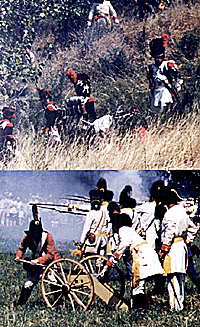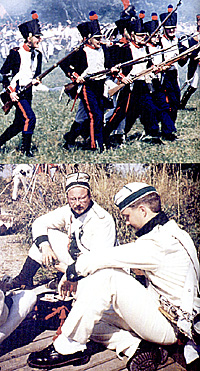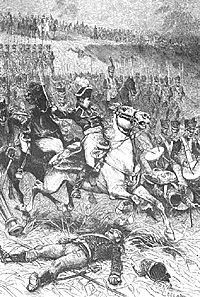 The weekend of 2nd-3rd July was a momentous one, witnessing
the culmination of two years' planning and determination, which
finally brought large-scale battle re-enactment to Austria. Those
two years had proved to be full of hard work and at times frustration
for the members of Forum Aspern, but through their perseverance,
they finally achieved their goal. The original idea had been for an
anniversary re-enactment of the storming of the Granary at Essling
to celebrate the 185th anniversary of the Battle of
AspernEssling, but opposition from the City of Vienna authorities
eventually proved too great and the project had to be abandoned
The weekend of 2nd-3rd July was a momentous one, witnessing
the culmination of two years' planning and determination, which
finally brought large-scale battle re-enactment to Austria. Those
two years had proved to be full of hard work and at times frustration
for the members of Forum Aspern, but through their perseverance,
they finally achieved their goal. The original idea had been for an
anniversary re-enactment of the storming of the Granary at Essling
to celebrate the 185th anniversary of the Battle of
AspernEssling, but opposition from the City of Vienna authorities
eventually proved too great and the project had to be abandoned
Undeterred, Remain Thomas Posenanski of Forum Aspern turned their attention to Deutsch-Wagram, where they received a more positive response. The planning for this new event did not escape its share of petty local difficulties, but Forum Aspern were not to be daunted and all obstacles were overcome.
On Friday, 1st July, the participants from all across Europe began to arrive and take their places in the extremely well-appointed campsite. Such luxuries as toilet blocks with electric lights, showers and a bar that never seemed to close were available! The 'Austrian' contingent from the UK numbered 14, including three who drove all the way from Kent! At the camp at Helmahof, just to the north of Deutsch- Wagram village, we were joined by reenactors from Austria, Germany, the Czech Republic, Slovakia, France, Russia and Belgium. Unfortunately, noone had bothered to let the organisers know that the Russians were coming, but they seemed happy enough, singing and dancing throughout the first night!
On the first evening, the KK IR4 Deutschnneister and 1 Jaeger from the UK joined up with some German 'French' to visit the crypt of the church in the village at Markgrafneusiedl. Interred in this cavernous crypt lie the bones of many of the soldiers from both sides, who perished during the fierce fighting, which engulfed this village during the battle of Wagram. Representatives from the Austrian and French units present laid a wreath to their memory.
 The following morning, we all moved to Vienna
and took part in a large parade of all the participants
and other uniformed groups in the grounds of the
majestic Schonbrunn Palace. Although there was
some confusion here at times, which was not helped
by the searing heat, all eventually went off more or
less according to plan, much to the delight of the
multitude of Japanese tourists.
The following morning, we all moved to Vienna
and took part in a large parade of all the participants
and other uniformed groups in the grounds of the
majestic Schonbrunn Palace. Although there was
some confusion here at times, which was not helped
by the searing heat, all eventually went off more or
less according to plan, much to the delight of the
multitude of Japanese tourists.
On Saturday evening, everyone paraded again and began a wearying march to Deutsch-Wagram for a ceremony at the monument in the Sachsenklemme in the village. Here we were joined by various local dignitaries and representatives from Europe's modern- day military powers as well as a local choir. The ceremony, which continued until well after dark, culminated in the laying of two wreaths accompanied by the memorable flash and crash of musket volleys, which erupted into the dark night. With the conclusion of the formal part of the evening, those with a thirst to quench retired to a local hotel for a little liquid refreshment. I think the wedding party that were also at the hotel were a little surprised by our appearance. A shotgun wedding perhaps, who knows? However, our evening wasn't over - we had been selected for Guard duty - the 2.00 a.m. to 4.00 a.m. slot. The joys of re-enactment know no bounds!
After a sleepless night, Sunday dawned early - the battle was to start at 10.00 a.m.! Breakfast itself was earlier than is normally acceptable to human beings and then we were off. The French led the column with the Austrians following. As we approached the historic battlefield, the Austrian troops wheeled to the left and made their way up on to the heights of the Wagram.
Once in position on the top, you realise for the first time just what a commanding position this must have been during the battle, The grass and undergrowth on the Wagram was long and thick, a great impediment to rapid movement but we soon realised that we were to fight the battle on the flat ground below and so descended to our positions. There was no sign of the French, who were concealed in the distance beyond the Russbach stream. The concerns of the Austrian command that they would be heavily outnumbered by their French opponents were dispelled seconds before the first shots rang out. Like the arrival of the 7th Cavalry in all those Hollywood westerns, (and in marked contrast to Archduke John in 1809), the belated arrival of the missing units from the Czech Republic was a case of perfect timing. With no time for greetings, they were rushed into the frontline.
 The appearance of French skirmishers in the distance was opposed by a
forward movement of the Austrian 1es Jaeger, (a mixed unit from Austria and
the UK). A stiff firefight ensued, but as the French began to gain the upper
hand, the main Austrian line advanced in support and pushed back the French
while under heavy artillery fire. As the main Austrian line prepared to push the
skirmishers from the field, there was a sudden dramatic change as the sound
of French drums filled the air and the head of a large French column came into
view. The Austrian line halted; the main battle was about to begin.
The appearance of French skirmishers in the distance was opposed by a
forward movement of the Austrian 1es Jaeger, (a mixed unit from Austria and
the UK). A stiff firefight ensued, but as the French began to gain the upper
hand, the main Austrian line advanced in support and pushed back the French
while under heavy artillery fire. As the main Austrian line prepared to push the
skirmishers from the field, there was a sudden dramatic change as the sound
of French drums filled the air and the head of a large French column came into
view. The Austrian line halted; the main battle was about to begin.
The long French column continued to march across the front of the Austrian line, receiving heavy musketry, but due to the long range, taking very few casualties. Finally in position, the French line opened up with a crashing volley, forcing the Jaeger, who were dangerously exposed to withdraw to a position to the left of their main line, from where they could threaten the French right. After numerous exchanges of fire, the French mounted an attack against the Austrian line, but the resolute defenders held firm and drove the French back on their original positions. But casualties were beginning to mount amongst the Austrians. The commander, sensing that his men could not withstand another assault, sent orders down the line for a phased withdrawal. This was carried out well under the increasing French pressure, except on the far right of the line. Whether it was a language problem or not, we shall never know, but as the line withdrew, the Russian Cossacks, incongruously pressed into Austrian service, suddenly launched themselves forward into the oncoming Saxons.
The confusion of the melee lasted but a minute or so, but it was long enough to cause great concern amongst the French. The Cossack seems to have his own re-enactment rules. One burly Russian was seen heading back towards the Wagram with a Saxon cantiniere across his shoulder! With order restored, the withdrawal continued but again the Cossacks attacked: only the intervention of two more French units and the Austrian commanders succeeded in forcing the Russians to finally follow the rest of the Austrian line back to the Wagram. The battle was over: As history dictated, the French had won the day, but it was not an easy victory and the Austrians left the field largely intact.
The large crowd mingled freely with the participants after the battle, although the soldiers were more intent on finding water on what was proving to be another scorching, burning day, exactly as it had been 185 years previously. Everyone who took part enjoyed themselves tremendously and we all owe a great debt of thanks to Forum Aspern for the massive effort they put in to make the whole event possible. Congratulations to them and we are all looking forward to returning for the 190th anniversary in 1999!
In the meantime 1996 marks a special anniversary as the 300th birthday of KK IR4 'Deutschmeister' and the 1,000th anniversary of both Vienna and Austria.
Back to Age of Napoleon 19 Table of Contents
Back to Age of Napoleon List of Issues
Back to MagWeb Master List of Magazines
© Copyright 1996 by Partizan Press.
This article appears in MagWeb (Magazine Web) on the Internet World Wide Web.
Other military history articles and gaming articles are available at http://www.magweb.com